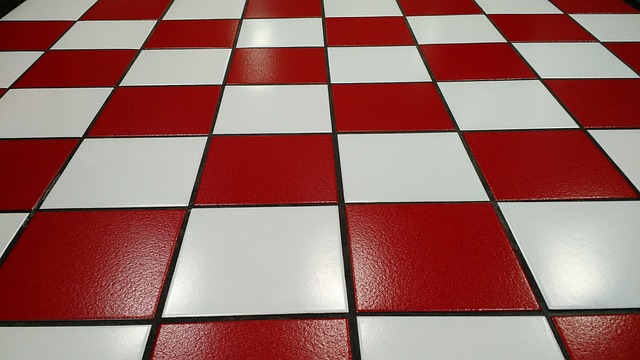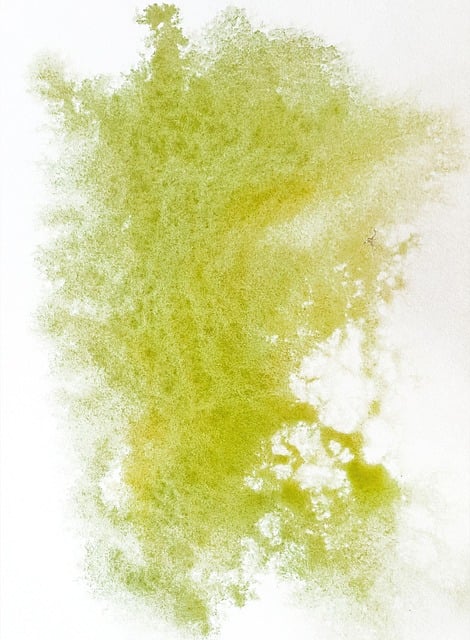Grout stain removal is a multifaceted process influenced by water damage, mold growth, dirt accumulation, and improper sealing. Preventative measures include regular cleaning, sealing, and prompt leak repairs. Professional services employ specialized tools and chemicals for deep cleaning without damaging grout or tiles. Different grout types require distinct care; cement-based grouts need mild detergents, while epoxy grouts demand stronger solutions. Essential tools for effective removal include a grout brush, vacuum/steam cleaner, acid-based cleaners, enzymes, oxygen-based bleaches, gloves, and goggles. A straightforward guide involves preparing the area, mixing warm water and detergent, applying it to stains, gently scrubbing, rinsing, and drying. Natural vs chemical cleaners balance eco-friendliness with stain penetration; proper handling is crucial for safety. Regular cleaning, sealing, and maintenance prevent future stains. Avoid using aggressive cleaners without understanding grout type or skipping pre-soaking and air drying. For stubborn stains, professional services with specialized tools offer optimal results.
Professional grout stain cleaning is a crucial aspect of maintaining your home’s aesthetics. Grout, while enhancing tile installations, is prone to staining from various sources, including spills, dirt, and mold. Understanding these stains’ causes and choosing the right tools can significantly impact the cleaning process. This comprehensive guide covers everything from identifying stain types to prevention tips, ensuring you tackle grout stains effectively. Discover natural vs chemical cleaners, learn common mistakes to avoid, and know when professional help is necessary for a spotless grout finish.
Understanding Grout Stain Causes

Grout stain removal can be a challenge because understanding the root causes of stains is crucial for effective cleaning. Stains in grout often result from various factors, including water damage, mold and mildew growth, dirt and debris accumulation, and even improper sealing or cleaning methods. Water penetration through cracks or gaps allows stains to set, while mold thrives in moist environments, leaving behind discoloration. Over time, grit from shoes, floor traffic, and everyday activities can grind away at the grout’s surface, causing discoloration.
Proper maintenance is key to preventing grout stains. Regular vacuuming and mopping can remove dirt and debris before they settle. Sealing the grout with a high-quality sealer is another effective measure. Identifying and addressing water leaks promptly is essential to avoid prolonged moisture exposure. In case of existing stains, professional cleaning services use specialized tools and chemicals designed for grout stain removal, ensuring deeper cleaning without damaging the grout or tiles.
Types of Grout and Their Staining Tendencies

Grout, a material often used to fill the spaces between tiles in flooring and countertops, comes in various types, each with its unique staining tendencies. The most common types include cement-based grout, which is susceptible to water stains and mold due to its porous nature. This type is commonly found in older homes and can be challenging to clean effectively without proper care. On the other hand, epoxy grout offers better resistance to stains and moisture, making it a popular choice for modern applications. However, it’s not immune to staining; oil, grease, and certain chemicals can still leave behind unsightly marks.
Porous grout types, like sanded and non-sanded cement grouts, require regular cleaning with mild detergents and steam cleaners to prevent stains from setting in. In contrast, non-porous epoxy grouts benefit from a more extensive cleaning routine involving strong solutions to dissolve and remove stubborn stains. Proper maintenance and understanding the specific type of grout in your space are essential for effective grout stain removal, ensuring your tiles and grout remain clean and visually appealing.
Essential Tools for Grout Stain Removal

When it comes to tackling grout stain removal, the right tools can make all the difference. Essential items in your cleaning arsenal include a good quality grout brush, designed to reach tight spaces and scrub away dirt and grime effectively. A powerful vacuum or steam cleaner is another must-have; these devices help to loosen and remove stubborn stains, especially when combined with suitable cleaning solutions.
Additionally, an array of cleaning chemicals tailored for grout stain removal will be invaluable. These include acid-based cleaners, enzymes, and oxygen-based bleaches, each offering unique benefits for different types of stains. Don’t forget protective gear like gloves and goggles to ensure a safe cleaning experience. With these tools at hand, you’ll be well-equipped to tackle even the most challenging grout stain removal tasks.
Step-by-Step Guide to Effective Cleaning

Removing grout stains can seem daunting, but with a few simple steps, you can achieve a fresh and clean look for your tiles. Here’s a comprehensive guide to effective grout stain removal.
Start by preparing the area. Sweep or vacuum any loose debris from the grout lines. Next, mix a solution of warm water and mild detergent using a spray bottle. Apply this mixture directly onto the stained grout, ensuring complete coverage. Let the solution sit for about 10-15 minutes to allow it to penetrate the stain. Using an old toothbrush or grout cleaning tool, gently scrub the stained areas in a back-and-forth motion. Rinse thoroughly with warm water and dry completely using a clean towel. If the stain persists, repeat the process, increasing the detergent concentration if needed.
Natural vs Chemical Cleansers: Which is Better?

When it comes to tackling grout stain removal, the age-old debate rages on: natural vs chemical cleaners. While natural options like baking soda and vinegar are popular for their eco-friendly appeal, they often lack the potency needed to penetrate and lift stubborn grout stains. These gentle methods are better suited for light cleaning and general maintenance.
On the other hand, chemical grout stain removers offer a more aggressive approach. They contain powerful ingredients designed to dissolve and remove even the most embedded stains. However, it’s essential to handle these chemicals with care, as they can be harsh on both the grout and surrounding surfaces if not used correctly. Balancing effectiveness and safety is key when selecting the best method for your grout stain removal needs.
Preventing Future Stains and Maintenance Tips

To prevent future grout stains, regular cleaning and maintenance are key. After completing a grout stain removal process, it’s essential to wipe down surfaces with a damp cloth to remove any lingering dirt or debris. Additionally, using non-absorbent mats at entryways can help minimize the tracking in of soil and moisture, which are primary causes of grout discoloration.
Ongoing maintenance includes sealing the grout regularly with a high-quality sealer to create a protective barrier against stains. This simple step can significantly extend the time between professional grout stain cleaning services. Remember, proactive care is always more effective (and less costly) than reactive remediation.
Common Mistakes to Avoid During the Cleaning Process

When tackling grout stain removal, it’s easy to make mistakes that can hinder your efforts or even cause further damage. One common blunder is using aggressive cleaning agents without understanding the type of stain or grout material. Different stains require specific approaches; applying the wrong cleaner could erode the grout or discolour it. Always identify the stain and choose a suitable, mild cleaner for optimal results.
Another mistake to avoid is skipping pre-soaking. Grout stains can be stubborn, so allowing the cleaning solution to saturate the affected area for an adequate period is crucial. Pre-soaking ensures that the cleaning agent penetrates deeply, thereby enhancing its effectiveness. Additionally, hasty drying after cleaning can lead to reabsorption of stains. Allow the grout to air dry completely between cleaning sessions to prevent recurring issues.
When to Seek Professional Help

If your grout stain removal efforts have been futile, it might be time to call in the experts. Professional grout cleaning services are equipped with specialized equipment and products designed specifically for tackling tough stains. They understand that not all grout stains respond to conventional cleaning methods, especially those caused by hard-to-remove substances like oil, wine, or ink.
Seeking professional help is also recommended if your grout is in a hard-to-reach area or if you’re dealing with a large-scale staining issue. DIY methods can be time-consuming and may not yield satisfactory results for extensive grout stain removal. Professionals can efficiently assess the situation and employ the most effective techniques to restore your grout’s original appearance without causing further damage.
